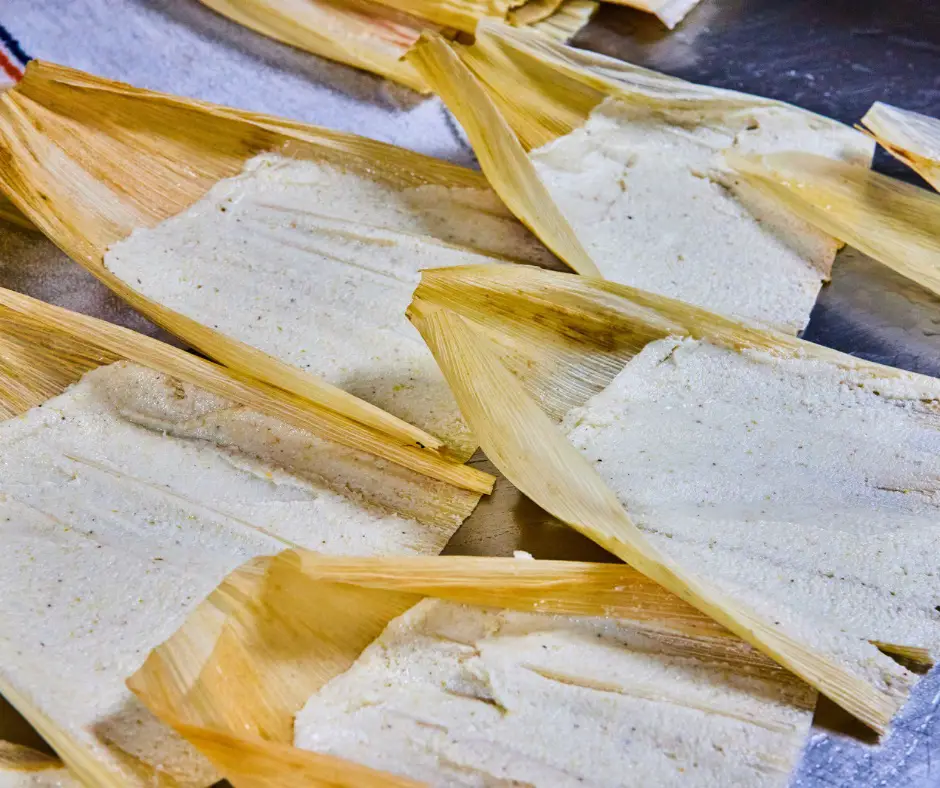Prepared masa is an already seasoned variation of plain masa, typically meant for tamale-making.
The beauty of prepared masa lies in its convenience – it’s all set and ready for use.
But here’s where it gets interesting: Can one tweak this pre-prepared mix further?
Can you add more ingredients to zest up the flavor or modify the texture of your tamales? Or do you just leave it untouched?
In this article, we will explore some popular additions people often incorporate into their store-bought prepared masa.

What Do You Add To Prepared Masa For Tamales: Lard? Water?
The answer is wrapped in simplicity – with your prepared masa, you really don’t need to add anything extra unless you wish to fine-tune the texture or flavour.
Some tamale experts prefer their masa on the softer side, adding a splash more water or broth into the mix.
Others yearn for that richer taste, achieving it by incorporating more shortening or lard.
If you desire a lighter touch, consider sprinkling in some baking powder. Those looking for a punchier bite might experiment with some spices too.
At the end of the day, it all boils down to your preference!
But truth be told, prepared masa is already perfectly primed and ready for use just as it arrives.
Feel free to roll up those sleeves and get steaming!
How To Work With Prepared Masa
The versatility of prepared masa is astounding – it can be converted into an array of dishes like tortillas, tamales, pupusas, breads, even dumplings.
However, understanding its texture is key to unlocking its potential.
When your masa feels too dry or crumbles upon touch, a little moisture is all it needs.
Adding some water or broth while kneading will transform it into a smooth and pliable dough.
Conversely, if the masa comes off as overly wet or sticky on your hands, sprinkle in additional masa harina and continue kneading until the ideal consistency is achieved.
Some ways to use prepared masa
Tamales
Lay some masa onto a soaked corn husk ensuring to leave margins for folding.
Nestle your preferred filling in the middle before folding over the husk to secure it within.
Tied at both ends using either corn husk strips or string, steam these delicious parcels for about an hour until fully cooked and firm.
Tortilla
Tortilla Trips involve dividing the dough into even portions which are then shaped into balls. A tortilla press or heavy skillet efficiently flattens these balls which are cooked on a hot griddle till they sport a lightly browned hue and puff up slightly.
Pupusas
You can also choose to make Pupusas with prepared masa. It has preparation similar to that of tortillas but with an integral stuffing of cheese, beans or meat within each disc. Once golden and crisp from their time on the griddle – dig into it!
Masa Bread
Want to bake some Masa Bread? Combine masa harina with all-purpose flour alongside baking powder, salt sugar butter and milk – kneading until you have smooth elastic dough. Nestled in greased loaf pan to rise for approximately an hour before being baked golden for half that time.
Dumplings
To make dumplings, follow the pack instructions for the perfect dough before rolling out small balls to be dropped in bubbling broth or soup. After about 15 minutes or so, they’re cooked thoroughly, rising up buoyantly towards the surface.
What’s The Difference Between Masa And Masa Preparada
Well, the answer lies in their composition and purpose.
Both are forms of corn dough, highly essential for creating a range of Latin American and Mexican delicacies such as tortillas, tamales and pupusas.
Masa stands as the fundamental dough that originates from ground corn cooked with lime water.
On the flip side, we have masa preparada – an amped-up version of masa boasting seasoning and enriched credentials that make it ready to use, specifically for making tamales.
Consider this – if masa was a canvas, then masa preparada would be the painting itself. It’s plain old masa jazzed up with additional ingredients rendering it perfect for tamale preparation.
Dried corn kernels form the nucleus for both these types of dough.
They are cooked and soaked in limewater in a process called nixtamalization making the corn richer in nutrition, flavor, and grindability.
Once nixtamalized, the corn transforms into a fine flour named masa harina or “dough flour”.
Add a little water to this flour et voila! You get pliable dough known as masa capable of transforming into tortillas, empanadas, pupusas, and more.
Take this up a notch to arrive at Masa preparada or “prepared dough”, where our base masa mingles with broth, lard shortening, baking powder, salt and many more ingredients.
This dough is typically used to make tamales – small bundles wrapped in corn husks filled with meaty or cheesy goodness along with vegetables or other fillings.
Can You Leave Prepared Masa Out Overnight?
Prepared masa is not some shelf stable entity like dry pasta or canned beans. It is highly perishable and should never be left out overnight.
Leaving prepared masa out overnight invites a host of unwelcome possibilities – spoilage, fermentation, mold growth and even infestation by pests.
These unfortunate incidents affect the taste, quality and above all safety of your food.
So where does prepared masa stay fresh? In the snug confines of your refrigerator, it can comfortably live up-to a week or enjoy a six-month-long sojourn in your freezer.
Here’s how you should treat your prepared masa:
Firstly, wrap it in plastic wrap and place it in an air-tight container or vacuum-sealed bag.
This helps prevent it from drying out or picking up strange fridge odors (because no one wants their tortillas smelling like last night’s takeaway).
Next, slap on a label with the date when the masa was made or opened to help keep track of its shelf life.
When you’re ready to use the refrigerated or frozen masa, kindly let it come back to room temperature and give it another good knead to bring back its original texture and pliability.

